Business and the Business Environment: Sainsbury's Analysis Report
VerifiedAdded on 2021/02/20
|11
|3216
|50
Report
AI Summary
This report provides a comprehensive analysis of Sainsbury's business environment. It begins with an introduction to the concept of the business environment, focusing on macro factors and their impact on Sainsbury's operations. The report employs a PESTLE analysis to examine political, economic, social, technological, legal, and environmental factors, detailing their positive and negative effects on the company. Further, it conducts an internal and external analysis using SWOT analysis to identify Sainsbury's strengths, weaknesses, opportunities, and threats. The report then explores the interrelation between these strengths and weaknesses and the external macro factors, highlighting how the business must adapt to the changing environment. The analysis considers factors like government regulations, economic conditions, consumer behavior, and technological advancements, concluding with a summary of key findings and strategic implications for Sainsbury's.
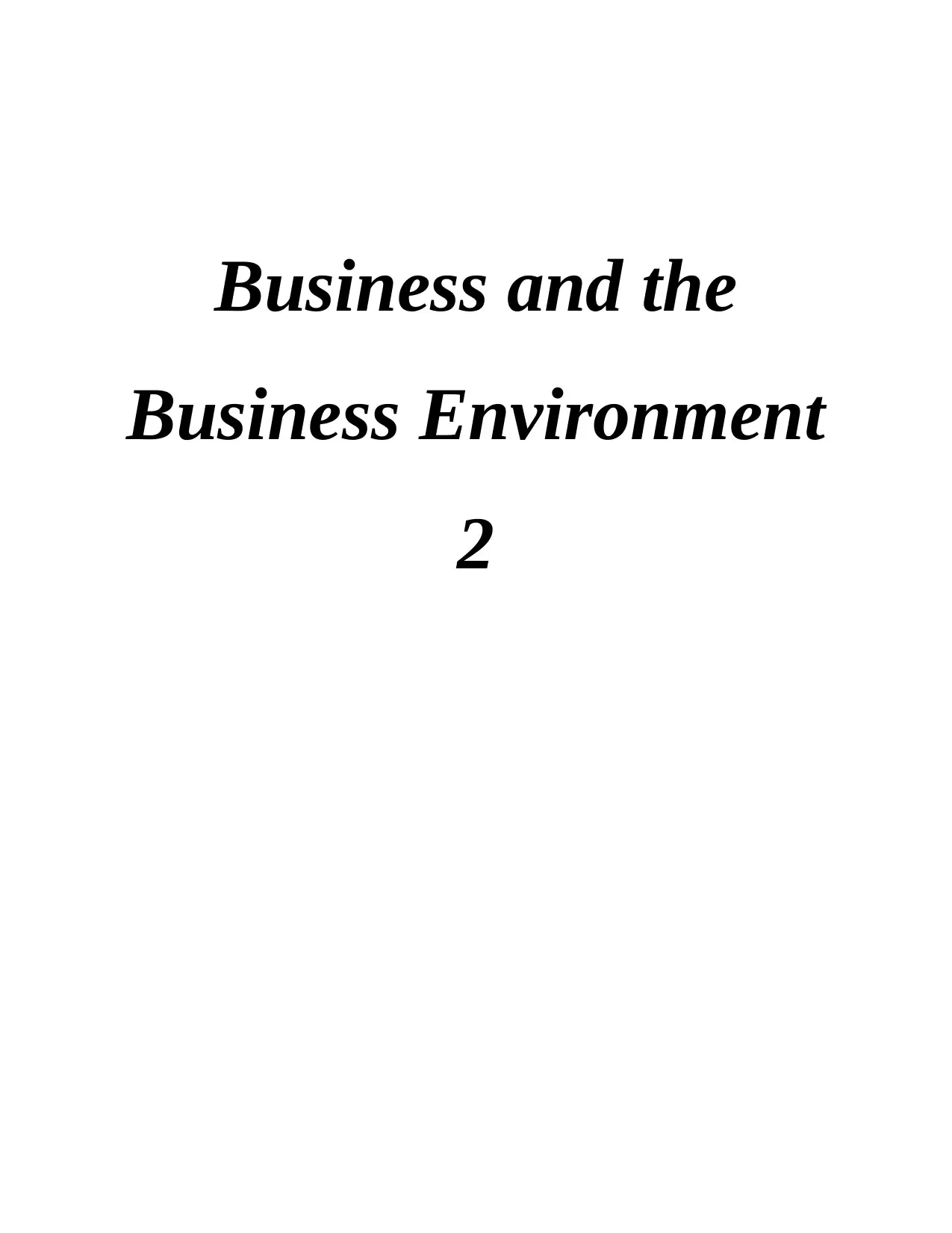
Business and the
Business Environment
2
Business Environment
2
Paraphrase This Document
Need a fresh take? Get an instant paraphrase of this document with our AI Paraphraser
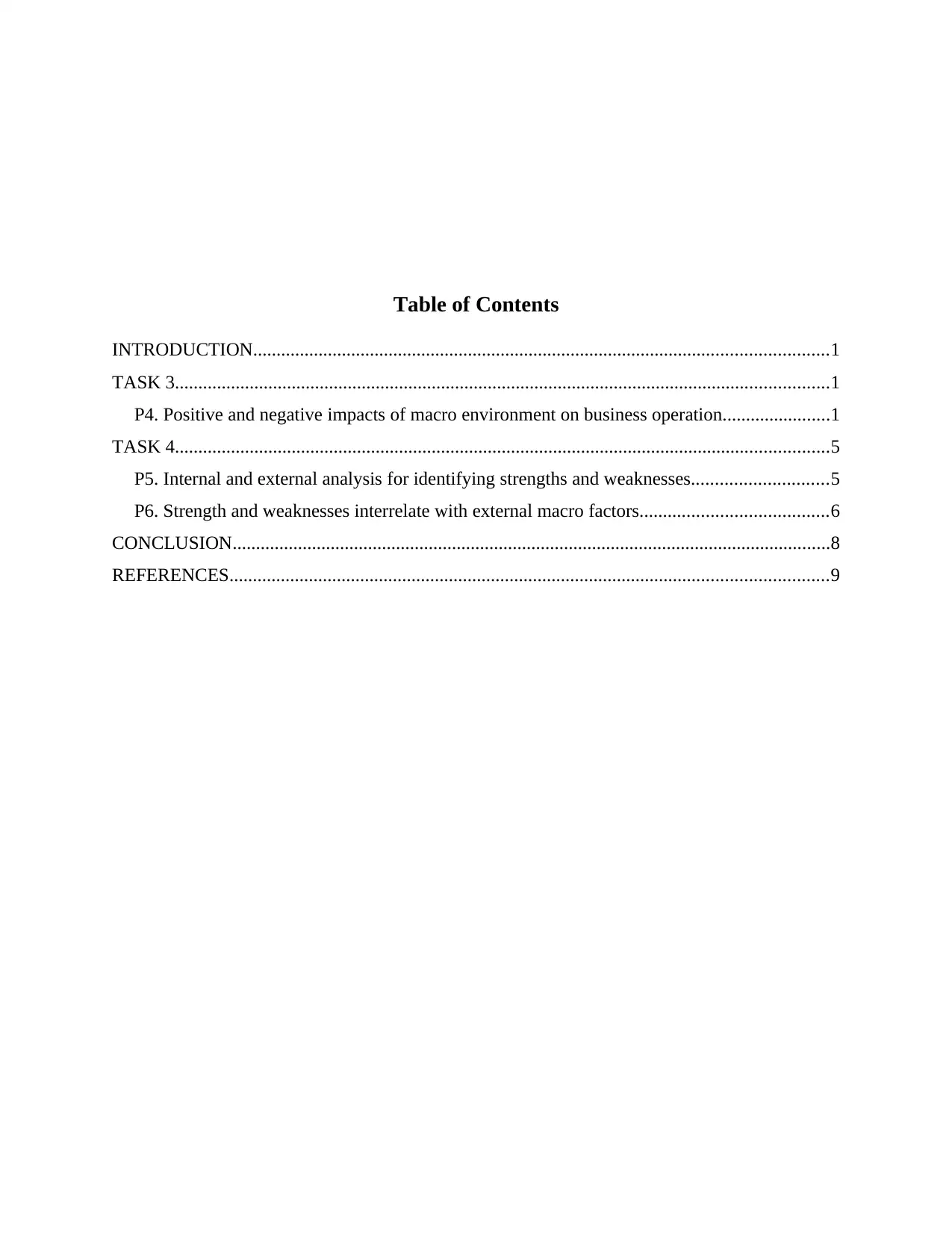
Table of Contents
INTRODUCTION...........................................................................................................................1
TASK 3............................................................................................................................................1
P4. Positive and negative impacts of macro environment on business operation.......................1
TASK 4............................................................................................................................................5
P5. Internal and external analysis for identifying strengths and weaknesses.............................5
P6. Strength and weaknesses interrelate with external macro factors........................................6
CONCLUSION................................................................................................................................8
REFERENCES................................................................................................................................9
INTRODUCTION...........................................................................................................................1
TASK 3............................................................................................................................................1
P4. Positive and negative impacts of macro environment on business operation.......................1
TASK 4............................................................................................................................................5
P5. Internal and external analysis for identifying strengths and weaknesses.............................5
P6. Strength and weaknesses interrelate with external macro factors........................................6
CONCLUSION................................................................................................................................8
REFERENCES................................................................................................................................9
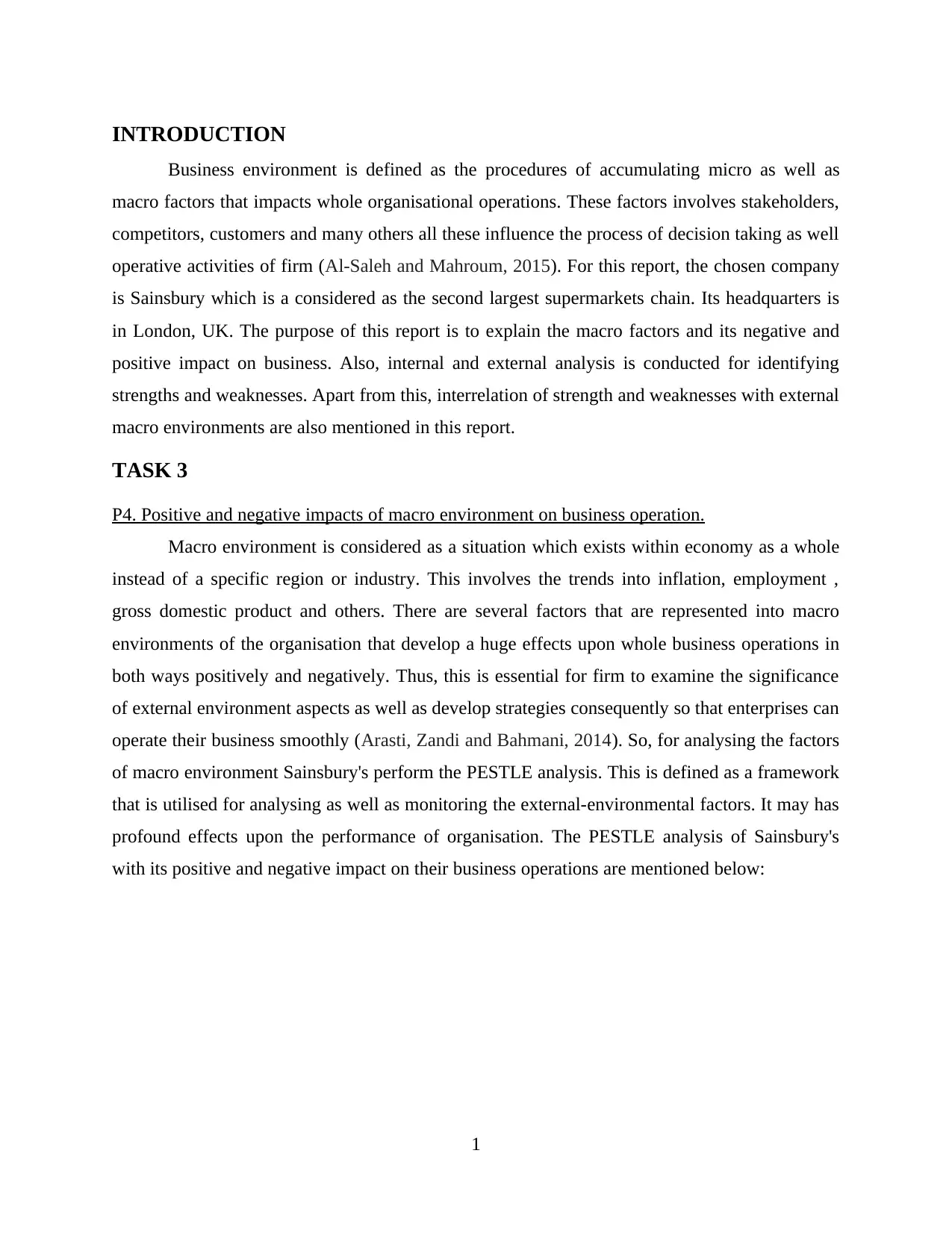
INTRODUCTION
Business environment is defined as the procedures of accumulating micro as well as
macro factors that impacts whole organisational operations. These factors involves stakeholders,
competitors, customers and many others all these influence the process of decision taking as well
operative activities of firm (Al-Saleh and Mahroum, 2015). For this report, the chosen company
is Sainsbury which is a considered as the second largest supermarkets chain. Its headquarters is
in London, UK. The purpose of this report is to explain the macro factors and its negative and
positive impact on business. Also, internal and external analysis is conducted for identifying
strengths and weaknesses. Apart from this, interrelation of strength and weaknesses with external
macro environments are also mentioned in this report.
TASK 3
P4. Positive and negative impacts of macro environment on business operation.
Macro environment is considered as a situation which exists within economy as a whole
instead of a specific region or industry. This involves the trends into inflation, employment ,
gross domestic product and others. There are several factors that are represented into macro
environments of the organisation that develop a huge effects upon whole business operations in
both ways positively and negatively. Thus, this is essential for firm to examine the significance
of external environment aspects as well as develop strategies consequently so that enterprises can
operate their business smoothly (Arasti, Zandi and Bahmani, 2014). So, for analysing the factors
of macro environment Sainsbury's perform the PESTLE analysis. This is defined as a framework
that is utilised for analysing as well as monitoring the external-environmental factors. It may has
profound effects upon the performance of organisation. The PESTLE analysis of Sainsbury's
with its positive and negative impact on their business operations are mentioned below:
1
Business environment is defined as the procedures of accumulating micro as well as
macro factors that impacts whole organisational operations. These factors involves stakeholders,
competitors, customers and many others all these influence the process of decision taking as well
operative activities of firm (Al-Saleh and Mahroum, 2015). For this report, the chosen company
is Sainsbury which is a considered as the second largest supermarkets chain. Its headquarters is
in London, UK. The purpose of this report is to explain the macro factors and its negative and
positive impact on business. Also, internal and external analysis is conducted for identifying
strengths and weaknesses. Apart from this, interrelation of strength and weaknesses with external
macro environments are also mentioned in this report.
TASK 3
P4. Positive and negative impacts of macro environment on business operation.
Macro environment is considered as a situation which exists within economy as a whole
instead of a specific region or industry. This involves the trends into inflation, employment ,
gross domestic product and others. There are several factors that are represented into macro
environments of the organisation that develop a huge effects upon whole business operations in
both ways positively and negatively. Thus, this is essential for firm to examine the significance
of external environment aspects as well as develop strategies consequently so that enterprises can
operate their business smoothly (Arasti, Zandi and Bahmani, 2014). So, for analysing the factors
of macro environment Sainsbury's perform the PESTLE analysis. This is defined as a framework
that is utilised for analysing as well as monitoring the external-environmental factors. It may has
profound effects upon the performance of organisation. The PESTLE analysis of Sainsbury's
with its positive and negative impact on their business operations are mentioned below:
1
⊘ This is a preview!⊘
Do you want full access?
Subscribe today to unlock all pages.

Trusted by 1+ million students worldwide
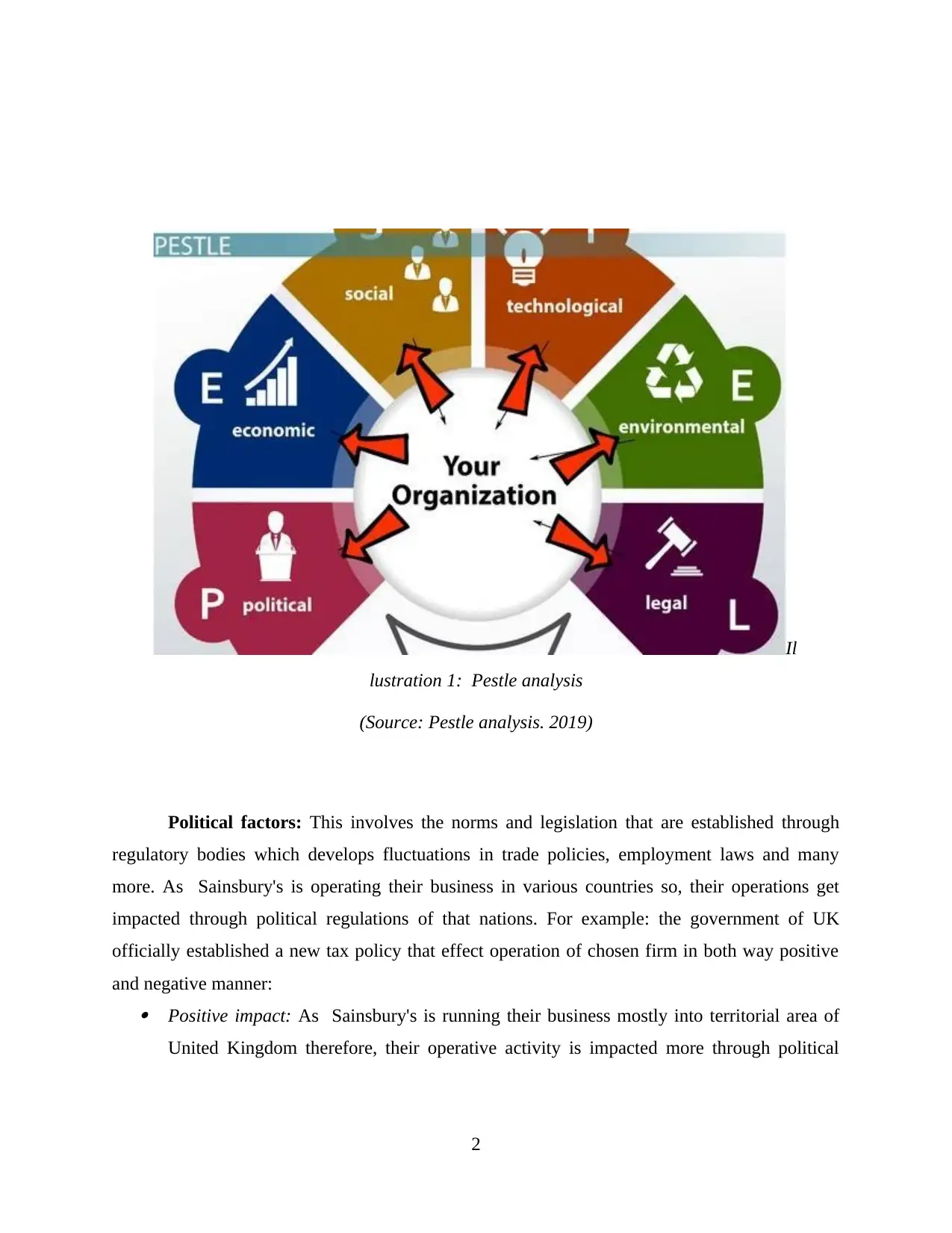
Political factors: This involves the norms and legislation that are established through
regulatory bodies which develops fluctuations in trade policies, employment laws and many
more. As Sainsbury's is operating their business in various countries so, their operations get
impacted through political regulations of that nations. For example: the government of UK
officially established a new tax policy that effect operation of chosen firm in both way positive
and negative manner: Positive impact: As Sainsbury's is running their business mostly into territorial area of
United Kingdom therefore, their operative activity is impacted more through political
2
Il
lustration 1: Pestle analysis
(Source: Pestle analysis. 2019)
regulatory bodies which develops fluctuations in trade policies, employment laws and many
more. As Sainsbury's is operating their business in various countries so, their operations get
impacted through political regulations of that nations. For example: the government of UK
officially established a new tax policy that effect operation of chosen firm in both way positive
and negative manner: Positive impact: As Sainsbury's is running their business mostly into territorial area of
United Kingdom therefore, their operative activity is impacted more through political
2
Il
lustration 1: Pestle analysis
(Source: Pestle analysis. 2019)
Paraphrase This Document
Need a fresh take? Get an instant paraphrase of this document with our AI Paraphraser
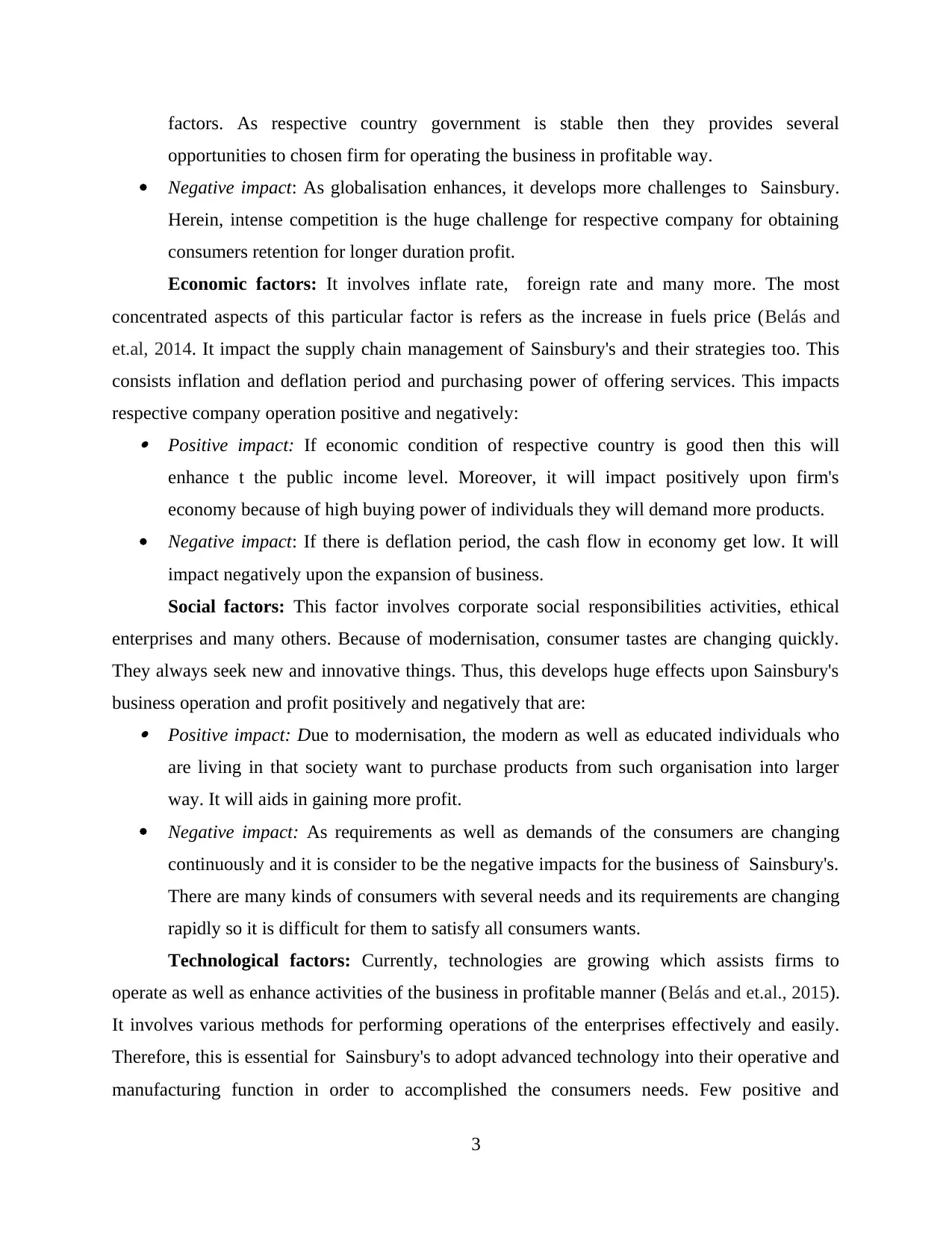
factors. As respective country government is stable then they provides several
opportunities to chosen firm for operating the business in profitable way.
Negative impact: As globalisation enhances, it develops more challenges to Sainsbury.
Herein, intense competition is the huge challenge for respective company for obtaining
consumers retention for longer duration profit.
Economic factors: It involves inflate rate, foreign rate and many more. The most
concentrated aspects of this particular factor is refers as the increase in fuels price (Belás and
et.al, 2014. It impact the supply chain management of Sainsbury's and their strategies too. This
consists inflation and deflation period and purchasing power of offering services. This impacts
respective company operation positive and negatively: Positive impact: If economic condition of respective country is good then this will
enhance t the public income level. Moreover, it will impact positively upon firm's
economy because of high buying power of individuals they will demand more products.
Negative impact: If there is deflation period, the cash flow in economy get low. It will
impact negatively upon the expansion of business.
Social factors: This factor involves corporate social responsibilities activities, ethical
enterprises and many others. Because of modernisation, consumer tastes are changing quickly.
They always seek new and innovative things. Thus, this develops huge effects upon Sainsbury's
business operation and profit positively and negatively that are: Positive impact: Due to modernisation, the modern as well as educated individuals who
are living in that society want to purchase products from such organisation into larger
way. It will aids in gaining more profit.
Negative impact: As requirements as well as demands of the consumers are changing
continuously and it is consider to be the negative impacts for the business of Sainsbury's.
There are many kinds of consumers with several needs and its requirements are changing
rapidly so it is difficult for them to satisfy all consumers wants.
Technological factors: Currently, technologies are growing which assists firms to
operate as well as enhance activities of the business in profitable manner (Belás and et.al., 2015).
It involves various methods for performing operations of the enterprises effectively and easily.
Therefore, this is essential for Sainsbury's to adopt advanced technology into their operative and
manufacturing function in order to accomplished the consumers needs. Few positive and
3
opportunities to chosen firm for operating the business in profitable way.
Negative impact: As globalisation enhances, it develops more challenges to Sainsbury.
Herein, intense competition is the huge challenge for respective company for obtaining
consumers retention for longer duration profit.
Economic factors: It involves inflate rate, foreign rate and many more. The most
concentrated aspects of this particular factor is refers as the increase in fuels price (Belás and
et.al, 2014. It impact the supply chain management of Sainsbury's and their strategies too. This
consists inflation and deflation period and purchasing power of offering services. This impacts
respective company operation positive and negatively: Positive impact: If economic condition of respective country is good then this will
enhance t the public income level. Moreover, it will impact positively upon firm's
economy because of high buying power of individuals they will demand more products.
Negative impact: If there is deflation period, the cash flow in economy get low. It will
impact negatively upon the expansion of business.
Social factors: This factor involves corporate social responsibilities activities, ethical
enterprises and many others. Because of modernisation, consumer tastes are changing quickly.
They always seek new and innovative things. Thus, this develops huge effects upon Sainsbury's
business operation and profit positively and negatively that are: Positive impact: Due to modernisation, the modern as well as educated individuals who
are living in that society want to purchase products from such organisation into larger
way. It will aids in gaining more profit.
Negative impact: As requirements as well as demands of the consumers are changing
continuously and it is consider to be the negative impacts for the business of Sainsbury's.
There are many kinds of consumers with several needs and its requirements are changing
rapidly so it is difficult for them to satisfy all consumers wants.
Technological factors: Currently, technologies are growing which assists firms to
operate as well as enhance activities of the business in profitable manner (Belás and et.al., 2015).
It involves various methods for performing operations of the enterprises effectively and easily.
Therefore, this is essential for Sainsbury's to adopt advanced technology into their operative and
manufacturing function in order to accomplished the consumers needs. Few positive and
3
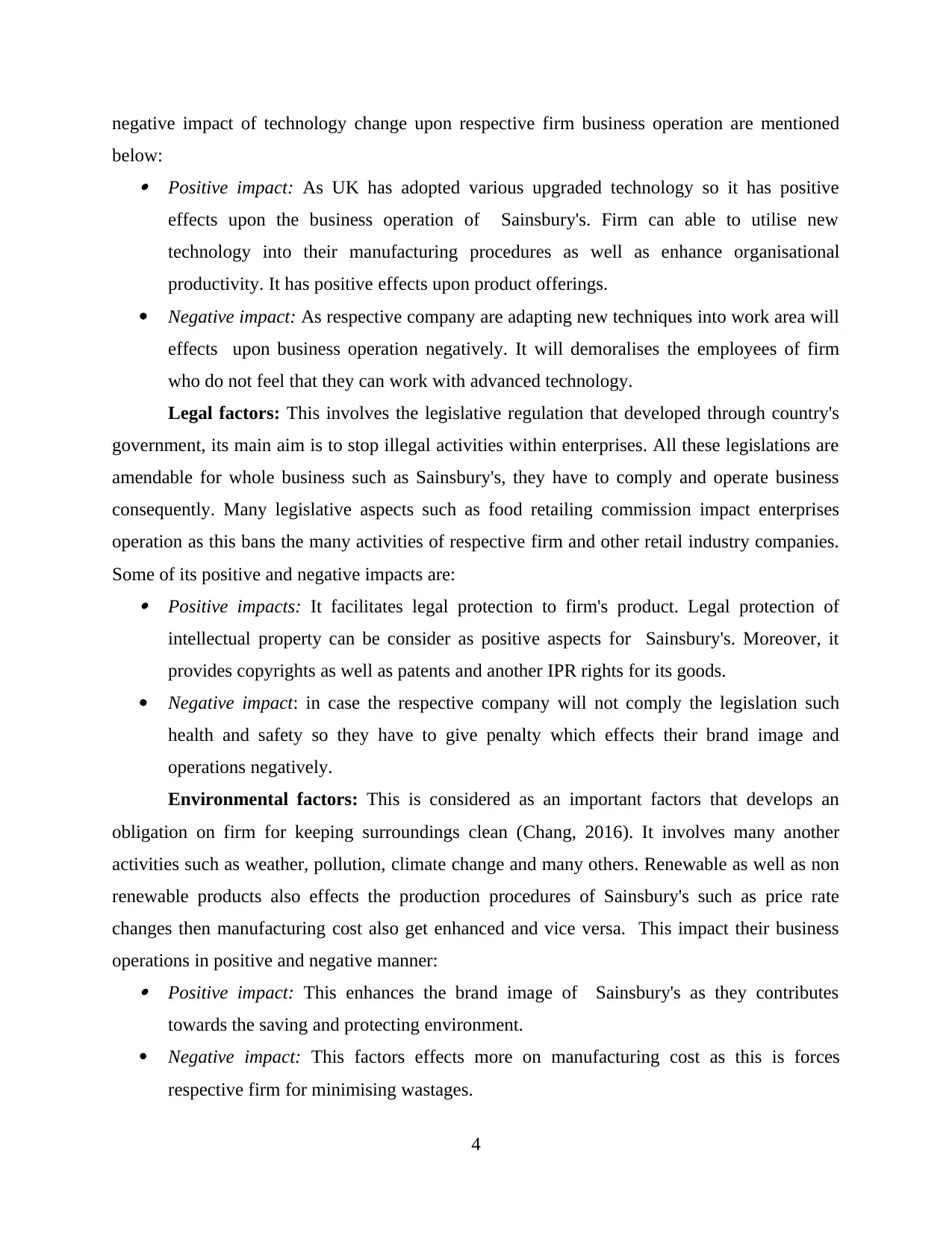
negative impact of technology change upon respective firm business operation are mentioned
below: Positive impact: As UK has adopted various upgraded technology so it has positive
effects upon the business operation of Sainsbury's. Firm can able to utilise new
technology into their manufacturing procedures as well as enhance organisational
productivity. It has positive effects upon product offerings.
Negative impact: As respective company are adapting new techniques into work area will
effects upon business operation negatively. It will demoralises the employees of firm
who do not feel that they can work with advanced technology.
Legal factors: This involves the legislative regulation that developed through country's
government, its main aim is to stop illegal activities within enterprises. All these legislations are
amendable for whole business such as Sainsbury's, they have to comply and operate business
consequently. Many legislative aspects such as food retailing commission impact enterprises
operation as this bans the many activities of respective firm and other retail industry companies.
Some of its positive and negative impacts are: Positive impacts: It facilitates legal protection to firm's product. Legal protection of
intellectual property can be consider as positive aspects for Sainsbury's. Moreover, it
provides copyrights as well as patents and another IPR rights for its goods.
Negative impact: in case the respective company will not comply the legislation such
health and safety so they have to give penalty which effects their brand image and
operations negatively.
Environmental factors: This is considered as an important factors that develops an
obligation on firm for keeping surroundings clean (Chang, 2016). It involves many another
activities such as weather, pollution, climate change and many others. Renewable as well as non
renewable products also effects the production procedures of Sainsbury's such as price rate
changes then manufacturing cost also get enhanced and vice versa. This impact their business
operations in positive and negative manner: Positive impact: This enhances the brand image of Sainsbury's as they contributes
towards the saving and protecting environment.
Negative impact: This factors effects more on manufacturing cost as this is forces
respective firm for minimising wastages.
4
below: Positive impact: As UK has adopted various upgraded technology so it has positive
effects upon the business operation of Sainsbury's. Firm can able to utilise new
technology into their manufacturing procedures as well as enhance organisational
productivity. It has positive effects upon product offerings.
Negative impact: As respective company are adapting new techniques into work area will
effects upon business operation negatively. It will demoralises the employees of firm
who do not feel that they can work with advanced technology.
Legal factors: This involves the legislative regulation that developed through country's
government, its main aim is to stop illegal activities within enterprises. All these legislations are
amendable for whole business such as Sainsbury's, they have to comply and operate business
consequently. Many legislative aspects such as food retailing commission impact enterprises
operation as this bans the many activities of respective firm and other retail industry companies.
Some of its positive and negative impacts are: Positive impacts: It facilitates legal protection to firm's product. Legal protection of
intellectual property can be consider as positive aspects for Sainsbury's. Moreover, it
provides copyrights as well as patents and another IPR rights for its goods.
Negative impact: in case the respective company will not comply the legislation such
health and safety so they have to give penalty which effects their brand image and
operations negatively.
Environmental factors: This is considered as an important factors that develops an
obligation on firm for keeping surroundings clean (Chang, 2016). It involves many another
activities such as weather, pollution, climate change and many others. Renewable as well as non
renewable products also effects the production procedures of Sainsbury's such as price rate
changes then manufacturing cost also get enhanced and vice versa. This impact their business
operations in positive and negative manner: Positive impact: This enhances the brand image of Sainsbury's as they contributes
towards the saving and protecting environment.
Negative impact: This factors effects more on manufacturing cost as this is forces
respective firm for minimising wastages.
4
⊘ This is a preview!⊘
Do you want full access?
Subscribe today to unlock all pages.

Trusted by 1+ million students worldwide
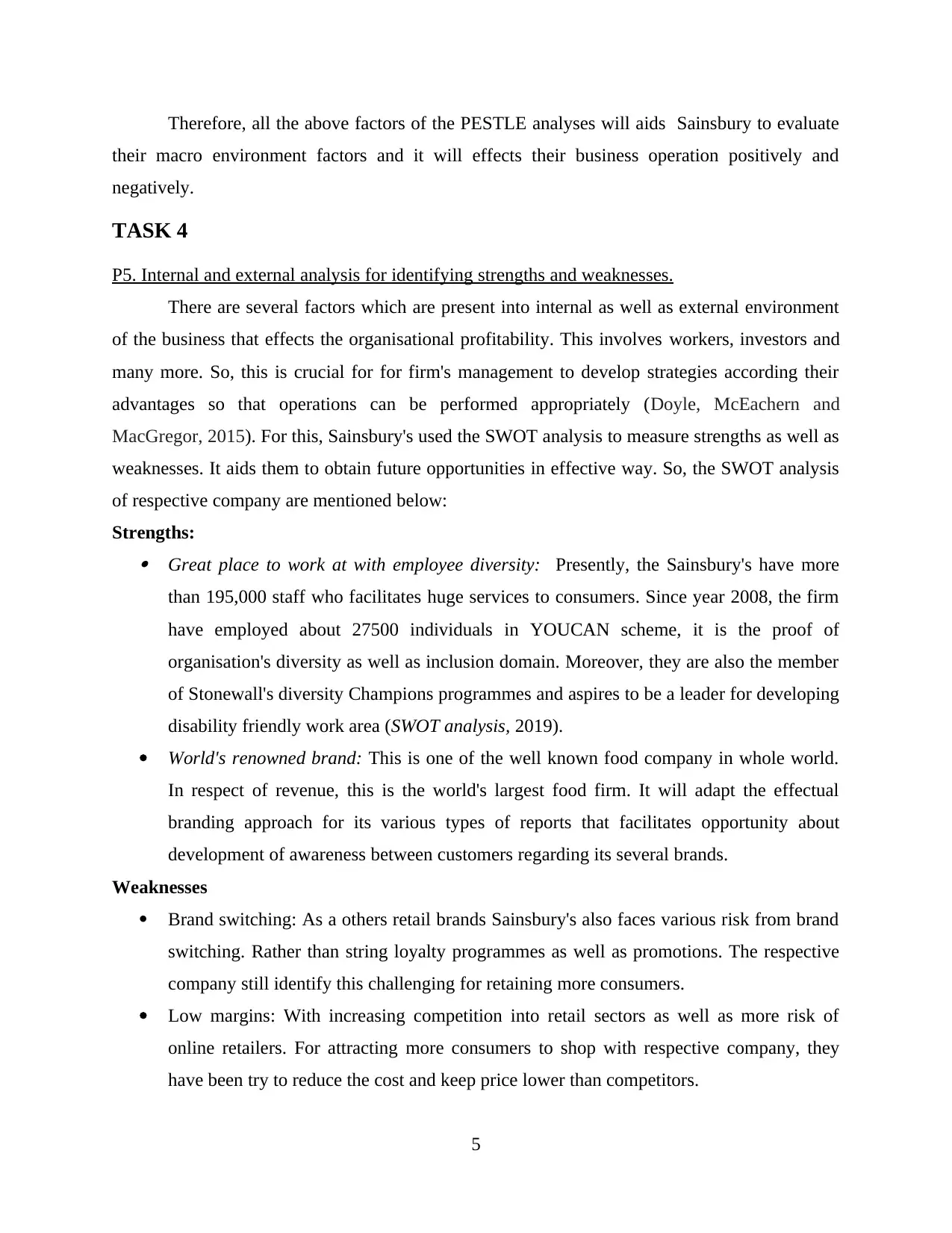
Therefore, all the above factors of the PESTLE analyses will aids Sainsbury to evaluate
their macro environment factors and it will effects their business operation positively and
negatively.
TASK 4
P5. Internal and external analysis for identifying strengths and weaknesses.
There are several factors which are present into internal as well as external environment
of the business that effects the organisational profitability. This involves workers, investors and
many more. So, this is crucial for for firm's management to develop strategies according their
advantages so that operations can be performed appropriately (Doyle, McEachern and
MacGregor, 2015). For this, Sainsbury's used the SWOT analysis to measure strengths as well as
weaknesses. It aids them to obtain future opportunities in effective way. So, the SWOT analysis
of respective company are mentioned below:
Strengths: Great place to work at with employee diversity: Presently, the Sainsbury's have more
than 195,000 staff who facilitates huge services to consumers. Since year 2008, the firm
have employed about 27500 individuals in YOUCAN scheme, it is the proof of
organisation's diversity as well as inclusion domain. Moreover, they are also the member
of Stonewall's diversity Champions programmes and aspires to be a leader for developing
disability friendly work area (SWOT analysis, 2019).
World's renowned brand: This is one of the well known food company in whole world.
In respect of revenue, this is the world's largest food firm. It will adapt the effectual
branding approach for its various types of reports that facilitates opportunity about
development of awareness between customers regarding its several brands.
Weaknesses
Brand switching: As a others retail brands Sainsbury's also faces various risk from brand
switching. Rather than string loyalty programmes as well as promotions. The respective
company still identify this challenging for retaining more consumers.
Low margins: With increasing competition into retail sectors as well as more risk of
online retailers. For attracting more consumers to shop with respective company, they
have been try to reduce the cost and keep price lower than competitors.
5
their macro environment factors and it will effects their business operation positively and
negatively.
TASK 4
P5. Internal and external analysis for identifying strengths and weaknesses.
There are several factors which are present into internal as well as external environment
of the business that effects the organisational profitability. This involves workers, investors and
many more. So, this is crucial for for firm's management to develop strategies according their
advantages so that operations can be performed appropriately (Doyle, McEachern and
MacGregor, 2015). For this, Sainsbury's used the SWOT analysis to measure strengths as well as
weaknesses. It aids them to obtain future opportunities in effective way. So, the SWOT analysis
of respective company are mentioned below:
Strengths: Great place to work at with employee diversity: Presently, the Sainsbury's have more
than 195,000 staff who facilitates huge services to consumers. Since year 2008, the firm
have employed about 27500 individuals in YOUCAN scheme, it is the proof of
organisation's diversity as well as inclusion domain. Moreover, they are also the member
of Stonewall's diversity Champions programmes and aspires to be a leader for developing
disability friendly work area (SWOT analysis, 2019).
World's renowned brand: This is one of the well known food company in whole world.
In respect of revenue, this is the world's largest food firm. It will adapt the effectual
branding approach for its various types of reports that facilitates opportunity about
development of awareness between customers regarding its several brands.
Weaknesses
Brand switching: As a others retail brands Sainsbury's also faces various risk from brand
switching. Rather than string loyalty programmes as well as promotions. The respective
company still identify this challenging for retaining more consumers.
Low margins: With increasing competition into retail sectors as well as more risk of
online retailers. For attracting more consumers to shop with respective company, they
have been try to reduce the cost and keep price lower than competitors.
5
Paraphrase This Document
Need a fresh take? Get an instant paraphrase of this document with our AI Paraphraser
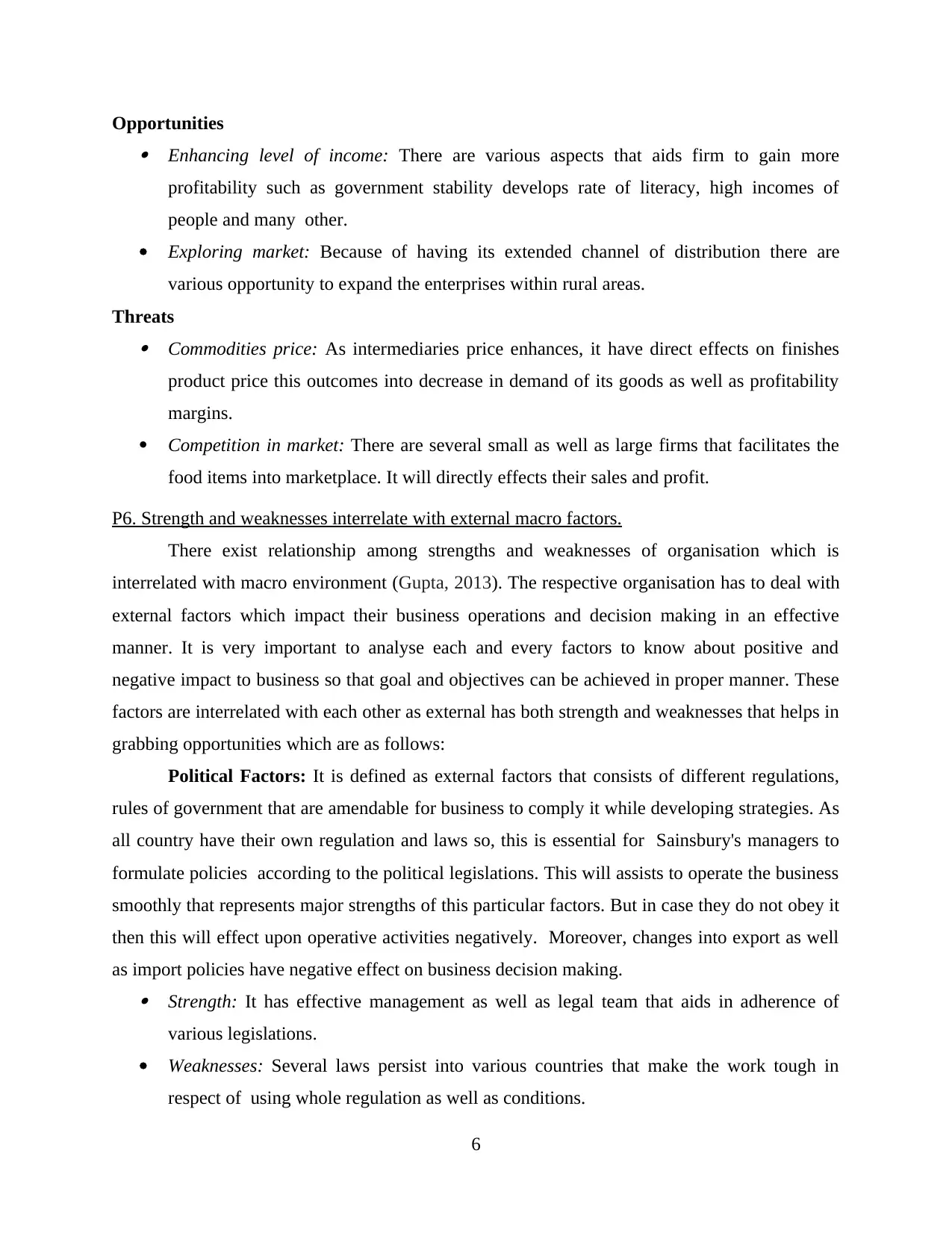
Opportunities Enhancing level of income: There are various aspects that aids firm to gain more
profitability such as government stability develops rate of literacy, high incomes of
people and many other.
Exploring market: Because of having its extended channel of distribution there are
various opportunity to expand the enterprises within rural areas.
Threats Commodities price: As intermediaries price enhances, it have direct effects on finishes
product price this outcomes into decrease in demand of its goods as well as profitability
margins.
Competition in market: There are several small as well as large firms that facilitates the
food items into marketplace. It will directly effects their sales and profit.
P6. Strength and weaknesses interrelate with external macro factors.
There exist relationship among strengths and weaknesses of organisation which is
interrelated with macro environment (Gupta, 2013). The respective organisation has to deal with
external factors which impact their business operations and decision making in an effective
manner. It is very important to analyse each and every factors to know about positive and
negative impact to business so that goal and objectives can be achieved in proper manner. These
factors are interrelated with each other as external has both strength and weaknesses that helps in
grabbing opportunities which are as follows:
Political Factors: It is defined as external factors that consists of different regulations,
rules of government that are amendable for business to comply it while developing strategies. As
all country have their own regulation and laws so, this is essential for Sainsbury's managers to
formulate policies according to the political legislations. This will assists to operate the business
smoothly that represents major strengths of this particular factors. But in case they do not obey it
then this will effect upon operative activities negatively. Moreover, changes into export as well
as import policies have negative effect on business decision making. Strength: It has effective management as well as legal team that aids in adherence of
various legislations.
Weaknesses: Several laws persist into various countries that make the work tough in
respect of using whole regulation as well as conditions.
6
profitability such as government stability develops rate of literacy, high incomes of
people and many other.
Exploring market: Because of having its extended channel of distribution there are
various opportunity to expand the enterprises within rural areas.
Threats Commodities price: As intermediaries price enhances, it have direct effects on finishes
product price this outcomes into decrease in demand of its goods as well as profitability
margins.
Competition in market: There are several small as well as large firms that facilitates the
food items into marketplace. It will directly effects their sales and profit.
P6. Strength and weaknesses interrelate with external macro factors.
There exist relationship among strengths and weaknesses of organisation which is
interrelated with macro environment (Gupta, 2013). The respective organisation has to deal with
external factors which impact their business operations and decision making in an effective
manner. It is very important to analyse each and every factors to know about positive and
negative impact to business so that goal and objectives can be achieved in proper manner. These
factors are interrelated with each other as external has both strength and weaknesses that helps in
grabbing opportunities which are as follows:
Political Factors: It is defined as external factors that consists of different regulations,
rules of government that are amendable for business to comply it while developing strategies. As
all country have their own regulation and laws so, this is essential for Sainsbury's managers to
formulate policies according to the political legislations. This will assists to operate the business
smoothly that represents major strengths of this particular factors. But in case they do not obey it
then this will effect upon operative activities negatively. Moreover, changes into export as well
as import policies have negative effect on business decision making. Strength: It has effective management as well as legal team that aids in adherence of
various legislations.
Weaknesses: Several laws persist into various countries that make the work tough in
respect of using whole regulation as well as conditions.
6
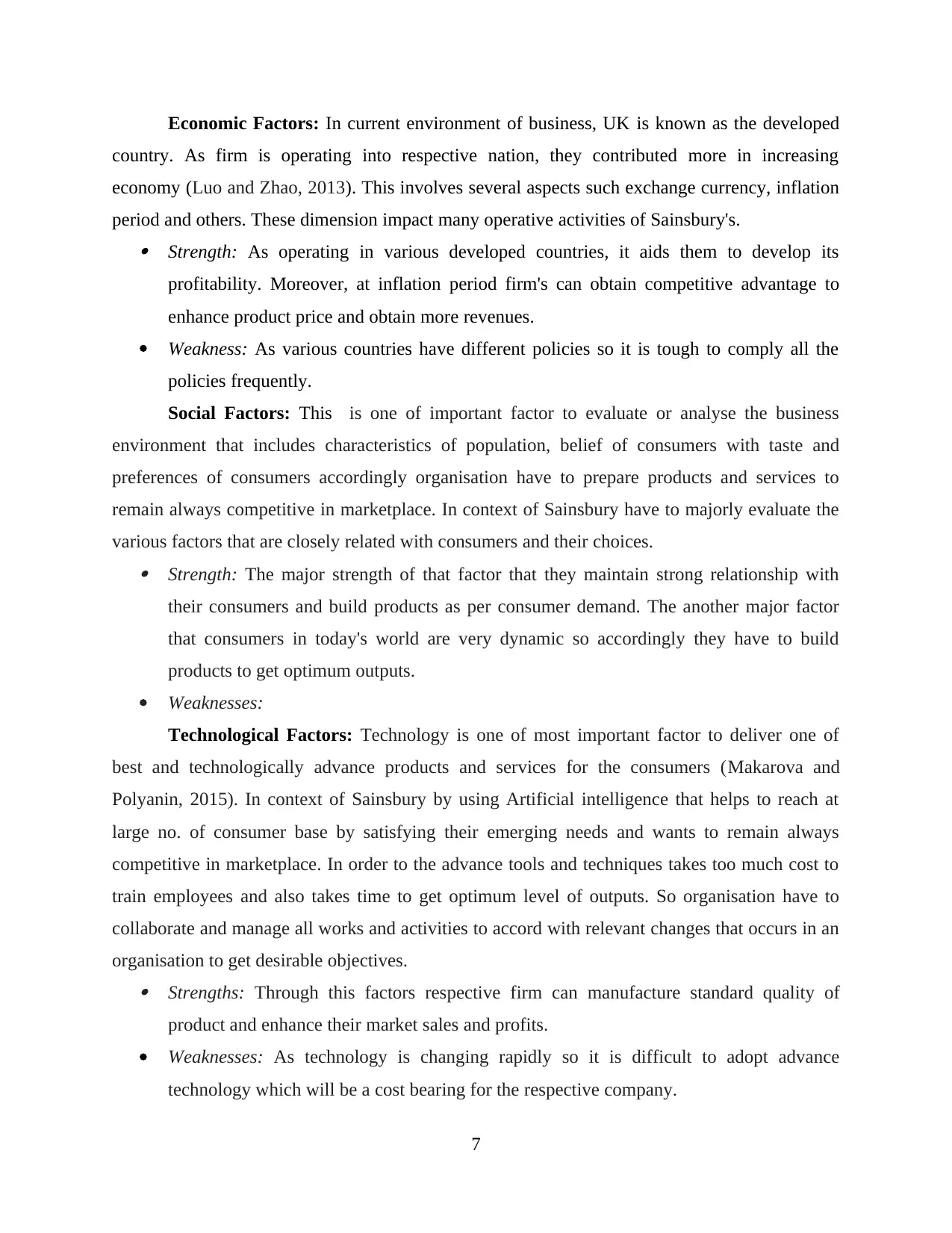
Economic Factors: In current environment of business, UK is known as the developed
country. As firm is operating into respective nation, they contributed more in increasing
economy (Luo and Zhao, 2013). This involves several aspects such exchange currency, inflation
period and others. These dimension impact many operative activities of Sainsbury's. Strength: As operating in various developed countries, it aids them to develop its
profitability. Moreover, at inflation period firm's can obtain competitive advantage to
enhance product price and obtain more revenues.
Weakness: As various countries have different policies so it is tough to comply all the
policies frequently.
Social Factors: This is one of important factor to evaluate or analyse the business
environment that includes characteristics of population, belief of consumers with taste and
preferences of consumers accordingly organisation have to prepare products and services to
remain always competitive in marketplace. In context of Sainsbury have to majorly evaluate the
various factors that are closely related with consumers and their choices. Strength: The major strength of that factor that they maintain strong relationship with
their consumers and build products as per consumer demand. The another major factor
that consumers in today's world are very dynamic so accordingly they have to build
products to get optimum outputs.
Weaknesses:
Technological Factors: Technology is one of most important factor to deliver one of
best and technologically advance products and services for the consumers (Makarova and
Polyanin, 2015). In context of Sainsbury by using Artificial intelligence that helps to reach at
large no. of consumer base by satisfying their emerging needs and wants to remain always
competitive in marketplace. In order to the advance tools and techniques takes too much cost to
train employees and also takes time to get optimum level of outputs. So organisation have to
collaborate and manage all works and activities to accord with relevant changes that occurs in an
organisation to get desirable objectives. Strengths: Through this factors respective firm can manufacture standard quality of
product and enhance their market sales and profits.
Weaknesses: As technology is changing rapidly so it is difficult to adopt advance
technology which will be a cost bearing for the respective company.
7
country. As firm is operating into respective nation, they contributed more in increasing
economy (Luo and Zhao, 2013). This involves several aspects such exchange currency, inflation
period and others. These dimension impact many operative activities of Sainsbury's. Strength: As operating in various developed countries, it aids them to develop its
profitability. Moreover, at inflation period firm's can obtain competitive advantage to
enhance product price and obtain more revenues.
Weakness: As various countries have different policies so it is tough to comply all the
policies frequently.
Social Factors: This is one of important factor to evaluate or analyse the business
environment that includes characteristics of population, belief of consumers with taste and
preferences of consumers accordingly organisation have to prepare products and services to
remain always competitive in marketplace. In context of Sainsbury have to majorly evaluate the
various factors that are closely related with consumers and their choices. Strength: The major strength of that factor that they maintain strong relationship with
their consumers and build products as per consumer demand. The another major factor
that consumers in today's world are very dynamic so accordingly they have to build
products to get optimum outputs.
Weaknesses:
Technological Factors: Technology is one of most important factor to deliver one of
best and technologically advance products and services for the consumers (Makarova and
Polyanin, 2015). In context of Sainsbury by using Artificial intelligence that helps to reach at
large no. of consumer base by satisfying their emerging needs and wants to remain always
competitive in marketplace. In order to the advance tools and techniques takes too much cost to
train employees and also takes time to get optimum level of outputs. So organisation have to
collaborate and manage all works and activities to accord with relevant changes that occurs in an
organisation to get desirable objectives. Strengths: Through this factors respective firm can manufacture standard quality of
product and enhance their market sales and profits.
Weaknesses: As technology is changing rapidly so it is difficult to adopt advance
technology which will be a cost bearing for the respective company.
7
⊘ This is a preview!⊘
Do you want full access?
Subscribe today to unlock all pages.

Trusted by 1+ million students worldwide
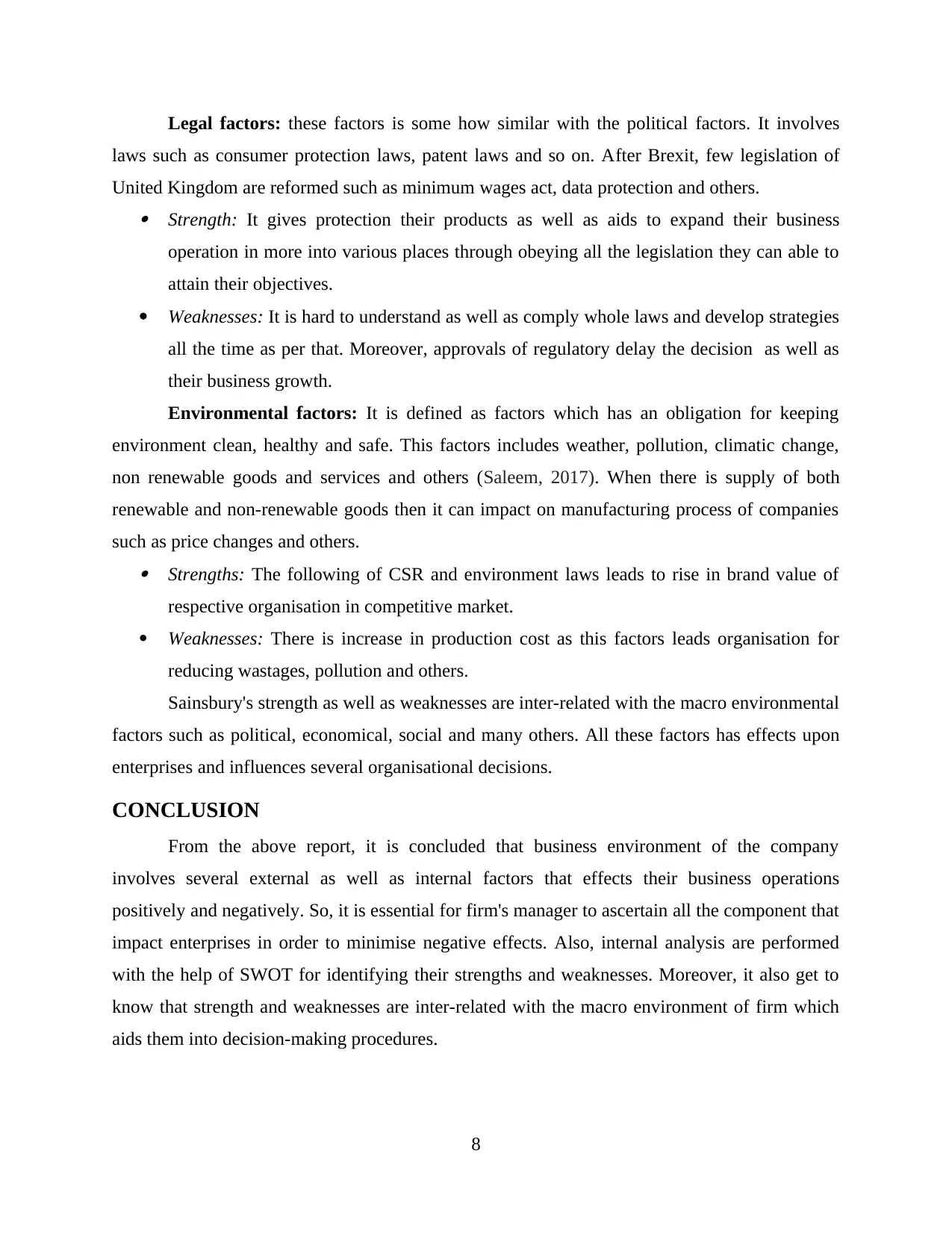
Legal factors: these factors is some how similar with the political factors. It involves
laws such as consumer protection laws, patent laws and so on. After Brexit, few legislation of
United Kingdom are reformed such as minimum wages act, data protection and others. Strength: It gives protection their products as well as aids to expand their business
operation in more into various places through obeying all the legislation they can able to
attain their objectives.
Weaknesses: It is hard to understand as well as comply whole laws and develop strategies
all the time as per that. Moreover, approvals of regulatory delay the decision as well as
their business growth.
Environmental factors: It is defined as factors which has an obligation for keeping
environment clean, healthy and safe. This factors includes weather, pollution, climatic change,
non renewable goods and services and others (Saleem, 2017). When there is supply of both
renewable and non-renewable goods then it can impact on manufacturing process of companies
such as price changes and others. Strengths: The following of CSR and environment laws leads to rise in brand value of
respective organisation in competitive market.
Weaknesses: There is increase in production cost as this factors leads organisation for
reducing wastages, pollution and others.
Sainsbury's strength as well as weaknesses are inter-related with the macro environmental
factors such as political, economical, social and many others. All these factors has effects upon
enterprises and influences several organisational decisions.
CONCLUSION
From the above report, it is concluded that business environment of the company
involves several external as well as internal factors that effects their business operations
positively and negatively. So, it is essential for firm's manager to ascertain all the component that
impact enterprises in order to minimise negative effects. Also, internal analysis are performed
with the help of SWOT for identifying their strengths and weaknesses. Moreover, it also get to
know that strength and weaknesses are inter-related with the macro environment of firm which
aids them into decision-making procedures.
8
laws such as consumer protection laws, patent laws and so on. After Brexit, few legislation of
United Kingdom are reformed such as minimum wages act, data protection and others. Strength: It gives protection their products as well as aids to expand their business
operation in more into various places through obeying all the legislation they can able to
attain their objectives.
Weaknesses: It is hard to understand as well as comply whole laws and develop strategies
all the time as per that. Moreover, approvals of regulatory delay the decision as well as
their business growth.
Environmental factors: It is defined as factors which has an obligation for keeping
environment clean, healthy and safe. This factors includes weather, pollution, climatic change,
non renewable goods and services and others (Saleem, 2017). When there is supply of both
renewable and non-renewable goods then it can impact on manufacturing process of companies
such as price changes and others. Strengths: The following of CSR and environment laws leads to rise in brand value of
respective organisation in competitive market.
Weaknesses: There is increase in production cost as this factors leads organisation for
reducing wastages, pollution and others.
Sainsbury's strength as well as weaknesses are inter-related with the macro environmental
factors such as political, economical, social and many others. All these factors has effects upon
enterprises and influences several organisational decisions.
CONCLUSION
From the above report, it is concluded that business environment of the company
involves several external as well as internal factors that effects their business operations
positively and negatively. So, it is essential for firm's manager to ascertain all the component that
impact enterprises in order to minimise negative effects. Also, internal analysis are performed
with the help of SWOT for identifying their strengths and weaknesses. Moreover, it also get to
know that strength and weaknesses are inter-related with the macro environment of firm which
aids them into decision-making procedures.
8
Paraphrase This Document
Need a fresh take? Get an instant paraphrase of this document with our AI Paraphraser
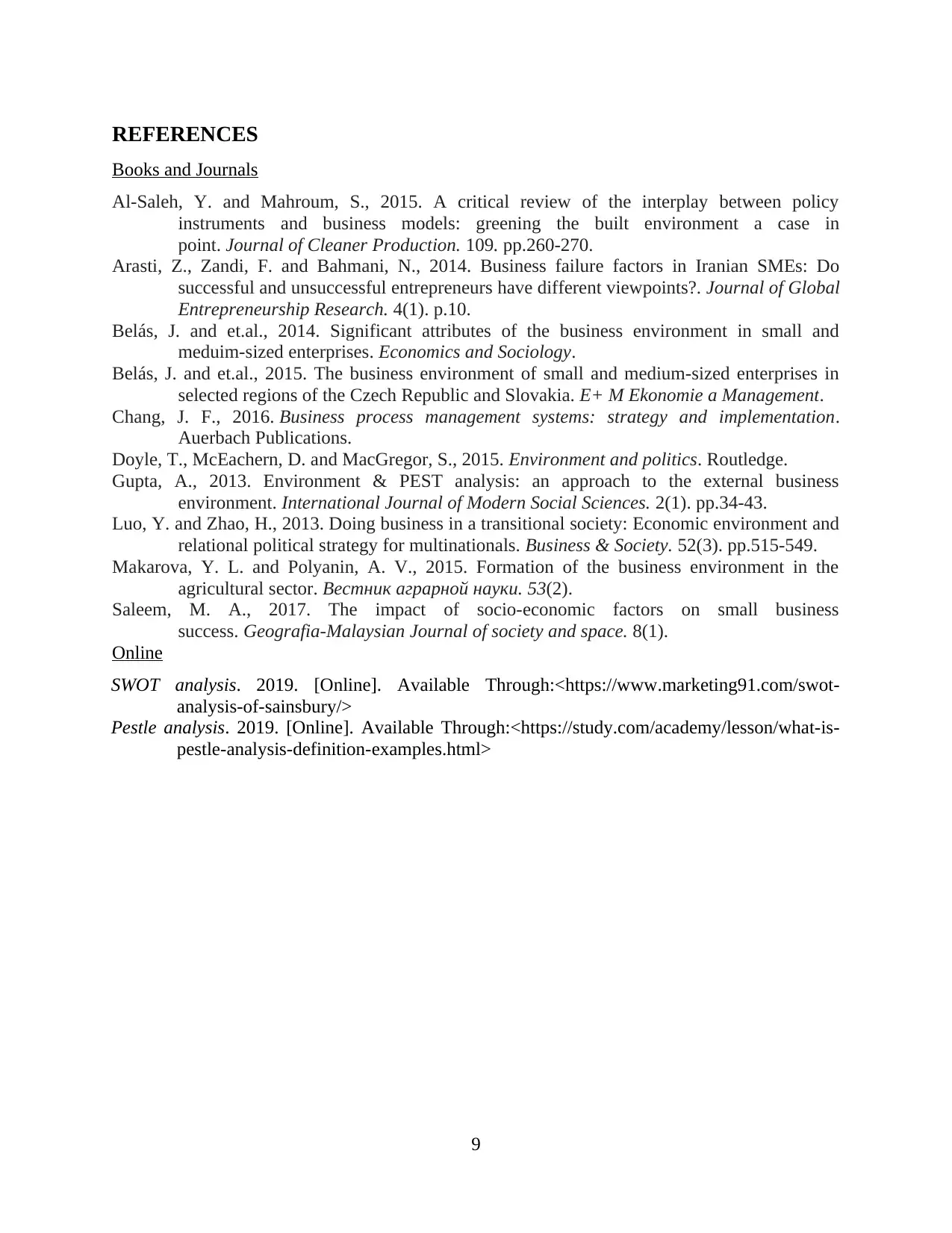
REFERENCES
Books and Journals
Al-Saleh, Y. and Mahroum, S., 2015. A critical review of the interplay between policy
instruments and business models: greening the built environment a case in
point. Journal of Cleaner Production. 109. pp.260-270.
Arasti, Z., Zandi, F. and Bahmani, N., 2014. Business failure factors in Iranian SMEs: Do
successful and unsuccessful entrepreneurs have different viewpoints?. Journal of Global
Entrepreneurship Research. 4(1). p.10.
Belás, J. and et.al., 2014. Significant attributes of the business environment in small and
meduim-sized enterprises. Economics and Sociology.
Belás, J. and et.al., 2015. The business environment of small and medium-sized enterprises in
selected regions of the Czech Republic and Slovakia. E+ M Ekonomie a Management.
Chang, J. F., 2016. Business process management systems: strategy and implementation.
Auerbach Publications.
Doyle, T., McEachern, D. and MacGregor, S., 2015. Environment and politics. Routledge.
Gupta, A., 2013. Environment & PEST analysis: an approach to the external business
environment. International Journal of Modern Social Sciences. 2(1). pp.34-43.
Luo, Y. and Zhao, H., 2013. Doing business in a transitional society: Economic environment and
relational political strategy for multinationals. Business & Society. 52(3). pp.515-549.
Makarova, Y. L. and Polyanin, A. V., 2015. Formation of the business environment in the
agricultural sector. Вестник аграрной науки. 53(2).
Saleem, M. A., 2017. The impact of socio-economic factors on small business
success. Geografia-Malaysian Journal of society and space. 8(1).
Online
SWOT analysis. 2019. [Online]. Available Through:<https://www.marketing91.com/swot-
analysis-of-sainsbury/>
Pestle analysis. 2019. [Online]. Available Through:<https://study.com/academy/lesson/what-is-
pestle-analysis-definition-examples.html>
9
Books and Journals
Al-Saleh, Y. and Mahroum, S., 2015. A critical review of the interplay between policy
instruments and business models: greening the built environment a case in
point. Journal of Cleaner Production. 109. pp.260-270.
Arasti, Z., Zandi, F. and Bahmani, N., 2014. Business failure factors in Iranian SMEs: Do
successful and unsuccessful entrepreneurs have different viewpoints?. Journal of Global
Entrepreneurship Research. 4(1). p.10.
Belás, J. and et.al., 2014. Significant attributes of the business environment in small and
meduim-sized enterprises. Economics and Sociology.
Belás, J. and et.al., 2015. The business environment of small and medium-sized enterprises in
selected regions of the Czech Republic and Slovakia. E+ M Ekonomie a Management.
Chang, J. F., 2016. Business process management systems: strategy and implementation.
Auerbach Publications.
Doyle, T., McEachern, D. and MacGregor, S., 2015. Environment and politics. Routledge.
Gupta, A., 2013. Environment & PEST analysis: an approach to the external business
environment. International Journal of Modern Social Sciences. 2(1). pp.34-43.
Luo, Y. and Zhao, H., 2013. Doing business in a transitional society: Economic environment and
relational political strategy for multinationals. Business & Society. 52(3). pp.515-549.
Makarova, Y. L. and Polyanin, A. V., 2015. Formation of the business environment in the
agricultural sector. Вестник аграрной науки. 53(2).
Saleem, M. A., 2017. The impact of socio-economic factors on small business
success. Geografia-Malaysian Journal of society and space. 8(1).
Online
SWOT analysis. 2019. [Online]. Available Through:<https://www.marketing91.com/swot-
analysis-of-sainsbury/>
Pestle analysis. 2019. [Online]. Available Through:<https://study.com/academy/lesson/what-is-
pestle-analysis-definition-examples.html>
9
1 out of 11
Related Documents
Your All-in-One AI-Powered Toolkit for Academic Success.
+13062052269
info@desklib.com
Available 24*7 on WhatsApp / Email
![[object Object]](/_next/static/media/star-bottom.7253800d.svg)
Unlock your academic potential
Copyright © 2020–2025 A2Z Services. All Rights Reserved. Developed and managed by ZUCOL.





